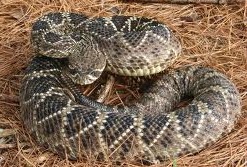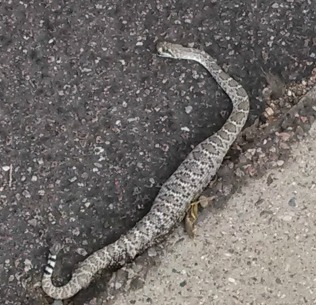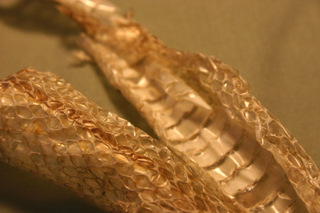
Arizona Rattlesnakes
Arizona Rattlesnakes are something that many people are not too fond of... but you have to admit, they are a beautiful creature, right? I am certainly one of those people.
How about YOU? Do you like rattlers? I certainly appreciate their beauty as I said, but I honestly have to say that I would rather not discover one unexpectedly while hiking. I have seen a few when hiking as one might expect. You just have to be aware of where you are walking and be conscious of where you are stepping.

Many people are afraid of poisonous snakes, me included. But the fact is, more times than not, people fear any AZ snake or any other snakes for that matter... usually it is because they don't understand them.
Perhaps you, too, would feel differently about Arizona snakes if had a greater understanding and maybe even love for these creatures, if you were better educated about Arizona Rattlesnakes.
Let's Explore Rattlers!
Here are some Rattlesnake Facts, according to Pima Community College, Tucson, Arizona
- Scientific Name: Canadensis
- Family Name for this AZ snake: Rattlesnake Mannagrass.
- You may know them or heard others refer to them as Western Diamondbacks.
- Here in The Sonoran Desert, we have 11 species of rattlesnakes, which is more than anywhere else in the world.
- They are one of the most highly specialized organisms.
- Fangs are said to be like retractable hypodermic needles!
Hopefully you have never been bit by one of these rattlers and never
do. I have never been bit by them and don't care to find out just how
much their fangs resemble hypodermic needles! I have seen a few news stories after someone has been bitten. If medical attention is sought quickly, people generally survive the bight with antivenom.
- Rattlesnakes will also shed their fangs about every 28 days, equal to about every 1.5 feedings.
- Their fangs can often be found inside a prey animal, later passed through the snake's digestive system.
- Snakes do not chew their food; it is easier for them to swallow their prey whole. By doing so, the limbs are able to fold up properly and do not hinder the swallowing process.
- Rattlesnake venom will break down blood. A snakes venom can also paralyze the nerves of the prey, which help subdue its prey, which is actually the very beginning of the digestive process.
- Rattlesnake nostrils are designed for smelling.
- A rattlesnake has something called Jacobson's Organ for augmenting smell. This organ is located on the roof of the mouth and interprets chemical scents delivered to it by their forked tongue.
- Each fork of the tongue collects chemicals from the ground and air. From there it is able to transfer it to the respective side of the Jacobson's Organ. This amazing organ then allows the snake to precisely determine which direction the prey is traveling.
- The Pit Organ, located at the corner of the snake's mouth, is most often used for seeing at night, but it can also be used when there is not enough light, too. This is actually how they they get their nickname, Pit Viper.
- The Pit Viper has pit organs which appear as holes located between each eye and the mouth, giving them the ability to sense heat.
- The rattler was most definitely blessed with sensation abilities! Even the body of a rattlesnake is able to sense animals through the ground vibrations that it feels.
- Female rattlesnakes give birth to live young that already have a prebutton on the end of their tail. Be careful though...the young snakes are in deed venomous!
- A new segment is added to the rattle after each shedding of the skin.
- The rattling sound that these snake are famous for producing is a result of the segments that rub against each other.
For more information on rattlesnakes, courtesy of the Arizona-Sonora Desert Museum in Tucson, click here.
Tips If Bitten By A Rattlesnake
Note that I am NOT giving you medical advice. It is strongly suggested that you seek immediate professional medical attention if injured in any way by a rattlesnake or any other type of snake or animal.
The following information serves only as a guide. Always consult professional advice for any and all snake bites or any animal injuries.
- If you have been bitten by a rattlesnake, consult a medical professional as soon as possible. CALL 9-1-1 for medical assistance.
- It is best to seek medical treatment immediately and extremely important to get to a hospital emergency room as soon as possible.
- Keep the victim as calm as possible and either transport them to the hospital immediately or call 9-1-1 if the medical condition of the person is severe.
- Do not chase the snake. The antivenin treatment for a rattlesnake bite does not require knowing what species the rattlesnake is, but if you note anything about the snake, relay that information to the professionals.
- Always use common sense and try to avoid any and all contact with snakes.
- This information provided is merely a guide that you can use until you are able to receive the recommended professional and immediate medical attention that is advised herein.
- Try to safely and quickly identify the species of snake if you are able to do so. Again, this is not required, just helpful.
- Slowly move the victim to a safe and secure area.
- Designate someone to be in charge of the decision process. This will save precious time as well as frustration.
- Remove any jewelry or tight fitting clothing on the victim.
- NEVER USE a tourniquet. I contacted poison control here in Arizona and I was told that you should never apply a tourniquet and you should never apply ice, or never try to suck out the venom as those things could cause tissue damage. In addition, you should always seek medical attention as soon as possible. Call 9-1-1 as soon as possible.
- It is important that you move the person as quickly as possible, but remember to try and not panic. If the victim sees you panic, this could very well worsen the situation by upsetting them more. Also keep in mind that the victim can be fine one moment and start to show signs of a severe reaction the next, so try to work as quickly and efficiently as possible.
- Monitor the victim for symptoms of shock while waiting for the medics to arrive.
- Elevate the part of the body that was bitten. If, for example, the victim was bitten on the leg, it is important to elevate his/her legs
- Avoid giving the bite victim any food or liquids.
- Try to keep bite victim immobile, comfortable and warm as much as possible.While keeping the victim immobile is important, getting them to a medical facility should be the priority.
- Movement to proper treatment facility is more crucial than maintaining immobile status.
IF YOU CHOOSE TO READ ONLY ONE THING ON THIS PAGE, JUST REMEMBER THIS:
- Transport the victim to a medical provider as soon as possible.
The quicker the response time the better. Responding to the victim
quickly in conjunction with a medical professional will likely reduce
the extent of the potential health threat.
- Try to take any pertinent information with you regarding the identity of the snake, if possible, ie: snake markings, where the incident occurred, etc.
- The more information you are able to provide the medics will help them to better treat the victim.
- Try to remain calm throughout the incident. This may be difficult to do, but added stress to the victim can add to the health concerns of the snake victim.
Common Questions About Rattlesnakes!
 |
I found this small rattlesnake dead on the street when I was going for a walk. It seems that he eat something too big for his size :( |
How Can You Tell If A Snake Is An Arizona Rattlesnake?
Look for the distinguishing marks. If it is a rattlesnake, it will have a flat, triangular shaped head. Many of these snakes will have coloration of patches with tan and brown.
Probably the easiest way to determine whether or not you are seeing a rattlesnake or not, is if you see the rattler that all of these snakes have.
Keep in mind that the younger Arizona Rattlesnakes may not have fully developed rattlers, which may be hard to identify at first glance, so be careful and do not get any closer!
What Time Do Snakes Come Out During The Day?
As with all reptiles, rattlesnakes, are not able to regulate their own body temperature. They are more active when it is cooler, but they can and do come out of hiding at any time of the day.
Here in the desert, Arizona Rattlesnakes can easily overheat and die if they cannot find a cool place to keep themselves cool. They like to stay cool underneath rocks or bushes where it is significantly cooler.
Behavioral thermoregulation is described when the snake selects these locations which help it moderate its internal body temperature.
Since these Arizona Rattlesnakes for the most part, eat rodents, this means that they are active during the night. Arizona Rattlesnakes like to hunt at night when the cooler air makes the heat image of the mammal stand out from its surrounding environment.
How Do You Determine How Old A Rattlesnake Is?
 |
Skin from a Western Diamond Back rattlesnake, as it is aging, the markings on it are fading. Author: xandert |
A common misconception some have had about determining the age of a snake is by the number of segments that a snake has in the rattle.
According the Arizona Game and Fish, (AZGFD) an Arizona snake's age is not determined by the segments it has. A rattlesnake adds a segment each time it sheds, which can happen more than once a year. It is also important to note that additionally, these segments will often break off.
How Deadly Are Them?
While the Arizona Rattlesnake is known as being venomous and a deadly reptile, there are actually very low fatality rates in humans. The bite is very painful, though and can be very frightening and should be taken very seriously.
You should still note that a large specimen of the common Western Diamondback can still consist of enough hemotoxic venom to kill an adult human. However, larger Arizona Rattlesnakes are usually less aggressive and most will only strike if they feel threatened or provoked.
Keep in mind that the smaller the body equals more potential danger to the bite victim. Also, the faster ones' metabolic rate and circulation, means greater potential for damage. Regardless of the possible serious health threat from Arizona Rattlesnakes, the key again, is to SEEK MEDICAL ATTENTION AS SOON AS POSSIBLE, as this WILL GREATLY IMPROVE the victim's chances of a complete recovery from the snake bite from any Arizona Rattlesnake.
The more the allergic reaction or negative side effects are, obviously the more damaging the bite.
A rapid response time will greatly reduce the potential serious health threats.
Arizona Rattlesnakes also have the ability to control their venom flow and will usually refrain from using all of its venom. Victim beware though! The bite can still cause extensive tissue damage in the bite area.
How Can I Keep Snakes Out Of My Yard?
You can reduce the appeal of your yard to snakes by following these 10 simple tips:
1. Cut your grass and keep it short. Keeping grass short will allow
greater visibility and help discourage snakes from hiding out in the
long grass to keep cool in the hot summer sun.
2. Control rodents in your living space outside. This will help
prevent Arizona Rattlesnakes believing that the outside of your home is a
welcome mat!
3. Keep your front and back yard free and clear of excess debris.
Arizona Rattlesnakes like to hide under things such as wood or brush.
Keep these items to a bare minimum to prevent them from being attracted.
4. While bird feeders are great to have as they provide a lot of viewing enjoyment to many, bird feeders attract snakes.
5. If you don't have a dog or cat, think about getting one. Just
the presence of a dog or cat in the yard, helps deter Arizona
Rattlesnakes! The odors that a dog or a cat gives off will help
discourage a snake from calling your yard home. It is very important to
note, though, you should NOT leave your dog or cat outside
unattended as the possibility for a coyote attacking your canine or
feline is becoming more and more common here in Arizona, as we continue to take over the coyotes living areas.
6. As mentioned, Arizona Rattlesnakes taste the air, and they do
not like the taste of sulfur. Consider purchasing powdered sulfur,
available in the gardening section at your local home improvement store.
The powdered sulfur is also good for preventing fleas and ticks!
7. Arizona Rattlesnakes are smart creatures and will travel where
food is. You can also help keep them away by keeping their prey, such
as mice, rats and birds, to a limit.
8. Mothballs are also a good deterrent against not only snakes, but small animals that you are trying to keep out.
9. Consider applying environmentally safe repellents. Many of these are non-toxic which are safe to use.
10. Think like a snake! This may sound silly, but I believe it is true. My pest control provider told me this once and I always remind myself of it. (He was actually telling me to think like ants at the time when I was having a problem with ants who were really becoming a problem in my back yard.)
If you think like a snake, you can help prevent their numbers. If you were a snake ask yourself where would you like to hide? Somewhere cool, right? And hopefully underneath something to help keep you cool, right? OK, you get the idea...
What Should I Do If I See A Snake?
DON'T touch it! Just leave it alone! You should know that most reported snake bites occur after someone attempts to capture or kill a rattlesnake.
Why Does A Snake Constantly Stick Out Its Tongue?
The tongue of the snake is acts as a highly developed sensor for it's taste perception.
When the tongue is fully stretched outward, the snake is able to communicate with its surroundings. The tongue works in conjunction with something inside of its mouth, known as the Jacobson's Organ.
This may sound really weird, but the snake can actually taste the air which enables them to assess such elements as danger, food, prey, etc.
Use the search box below to quickly find what you're looking for!
Return From Arizona Rattlesnakes To Arizona Wildlife
Return From Arizona Rattlesnakes To Home Page